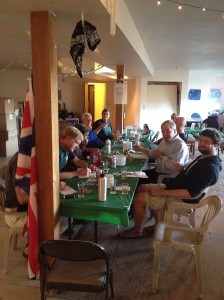notes from the “off flavors” tasting part 2, 6/27/14. Thanks again to Tyler for serving as MC. Thanks Mikael for the pics.
The first part of this tasting was so enjoyable that barely half as many people showed up for round 2. Since there were fewer people, and since in the first round most of us found at least some of the samples imperceptible, we mixed the flavor with only two cans of Coors, and the bad flavors just jumped out this time. Maybe not a good thing.
The kit from Siebel comes with very little information about the flavors and what might have caused them. The slides shown were found on the net on some homebrewing site. If Tyler can remember where and we can get permission from the creator we’ll post the slides here.
The description in bold is what the kit says, the rest is my personal comment. Here’s part 2 in the order we tasted them:
- Geraniol: Floral/Rose like — an unpleasant fruitiness. Despite the similar name this chemical is only a minor part of the geranium aroma.
- Indole: Farm/barnyard — “barnyard” is the polite language. In plain Anglo-Saxon, it smells like shit. Yes, literally. According to the slide only 50% of people perceive the “fecal” aroma, I’m one of that half. One whiff and I didn’t even consider drinking any.
- Isoamyl acetate: Banana esters / peardrop — as with the apple and spice flavors last time, wrong for a lager but not unpleasant
- Grainy: Husk like / Nut like — tannic, astringency on the back of the tongue.
- Isovaleric: Cheesy / old hops / sweaty socks — another seriously nasty one. As the pitcher was passed toward me the first few tasters were already complaining. Cheesy as in spoiled cheese that you should have thrown out a long time ago.
- Lactic: Sour / Sour milk — sour milk, nothing else to say
- Caprylic: Soapy, fatty, goaty — yecch. To me, pretty much the sour milk flavor again.
- Papery: Cardboard, oxidized — exactly; wet cardboard.
- Vanilla: Custard powder — familiar vanilla flavor
- Bitter: Hoppy / Bitter — bitterness past hoppy and into puckery and astringent.
- Infection: Sour / buttery — the sample must be fake butter flavor, it smelled EXACTLY like microwave popcorn.
- (extra). Untainted Coors light – To fool the participants — I said out loud that there was an aftertaste I didn’t like, and I’ll stand by that.
- Hefeweizen: Spicey + buttery esters — the sample is specifically CLOVE, strong and unmistakable. Too strong to be pleasant although I like Bavarian banana/clove hefeweizens.
